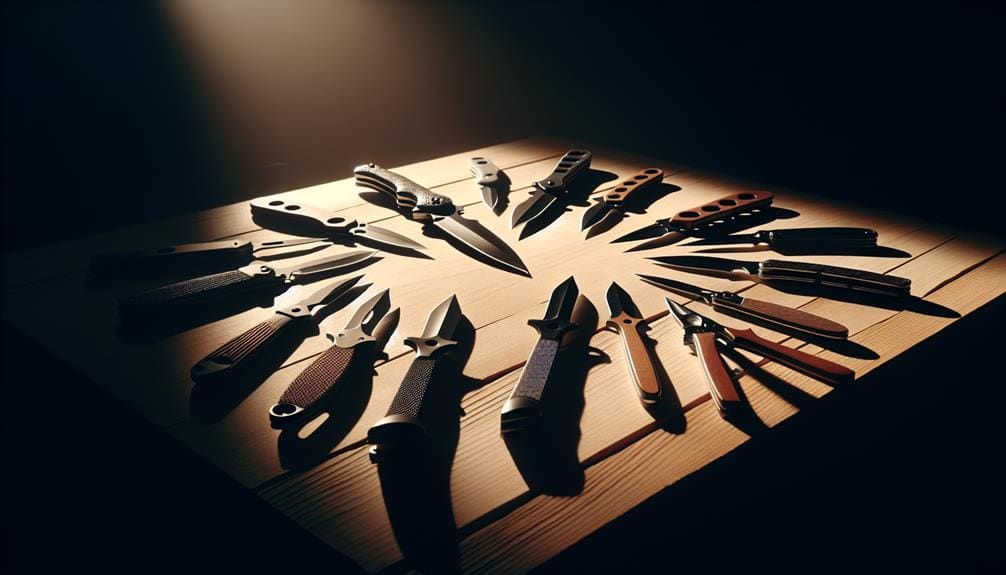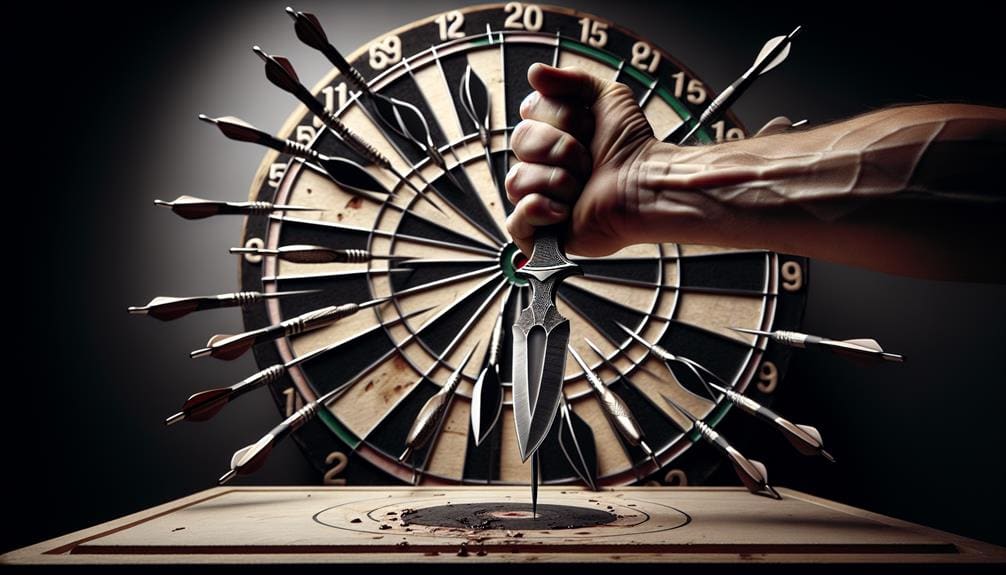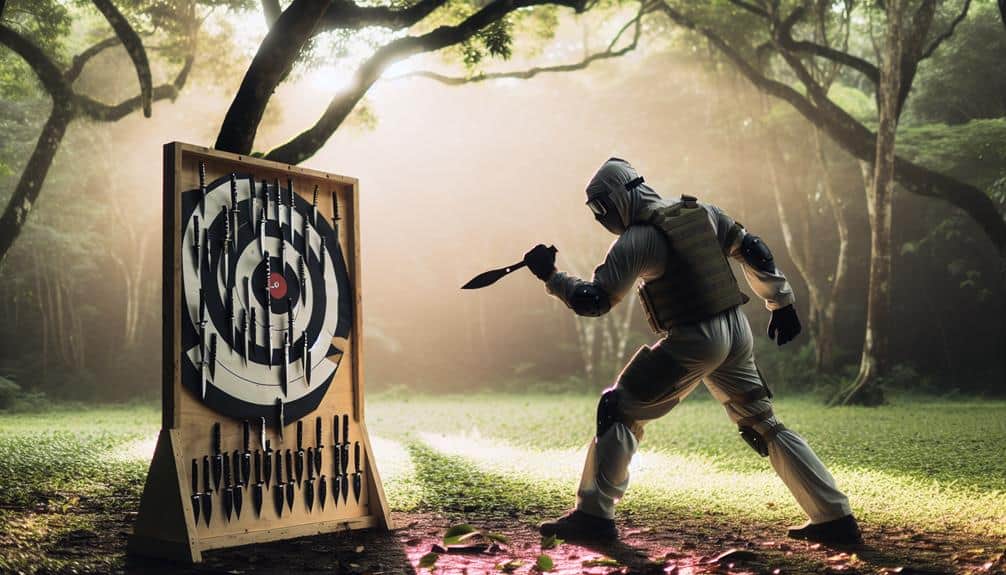
free shipping on orders over $25
We’re having a sale on all our products. Enter your email below to be notified about future sales.


We’re having a sale on all our products. Enter your email below to be notified about future sales.


Mastering throwing knives for personal protection combines stealth and strategy. Start by selecting knives with the right weight, balance, and non-slip grip. Learn proper grip and stance, and practice throwing at various distances to enhance accuracy and precision. Understand the optimal throwing distance (10-20 feet) and master timing for effective impact. Practice consistently, beginning with short distances. Use designated practice areas and wear protective gear to ensure safety. With dedication, you can turn throwing knives into an effective self-defense tool. To improve these skills and techniques further, there’s more to explore.

Selecting the right throwing knife is crucial for ensuring both accuracy and safety in personal protection. First, consider the weight, balance, and size of the knife. A well-balanced knife that fits comfortably in your hand enhances your accuracy and control. Lightweight knives are generally easier to throw, but heavier ones can provide more stability.
Next, focus on the material. Opt for knives made from durable materials like stainless steel or high carbon steel. These materials ensure your knives will stand the test of time, maintaining their performance through extensive use. A sharp point is essential for penetrating targets effectively, so ensure your knife has a reliably sharp tip.
Additionally, a non-slip grip is vital. It prevents the knife from slipping during a throw, which could compromise accuracy and safety. Look for knives that feature ergonomic designs for a secure hold.
For convenience and safety, choose a set that includes a sheath. This allows for safe storage and easy transportation.
Mastering throwing techniques is essential for making your throwing knives an effective tool for personal protection. You’ll need to start with the basics: learning the proper grip and stance. This foundation is crucial for optimal control and accuracy. Grip the knife firmly but not too tightly, and adopt a balanced stance with your feet shoulder-width apart.
Once you’ve got the basics down, practice throwing at various distances. This will help you develop muscle memory and improve your aim. Your release and follow-through should be consistent to ensure the knife spins correctly and hits the target point-first. Experiment with different throwing styles, such as overhead or sidearm, to see what works best for you.
Regular practice and patience are key to honing your skills. Here are some points to visualize:
Stay dedicated, and you’ll master throwing techniques, turning your knives into an effective personal protection tool.

To enhance your accuracy and precision with throwing knives, focus on practicing proper grip and release techniques consistently. Start by ensuring your grip is firm but not too tight, allowing for a smooth release. Practice releasing the knife in a fluid motion, minimizing wrist movement to maintain control.
Consistency is key. Regularly throw from the same distances and angles to develop muscle memory, which is crucial for accurate throws. Target practice is your best friend; it allows you to adjust your technique and understand how different distances impact your throws.
Understanding the aerodynamics of your knives will help optimize their flight path. Pay attention to how the knives behave mid-air and adjust your grip or release accordingly.
Maintenance is often overlooked but essential. Regularly sharpen your knives to ensure they penetrate the target effectively. A dull knife can disrupt your throws and lower your accuracy.
| Key Focus Areas | Tips for Mastery |
|---|---|
| Grip | Firm but not too tight |
| Release | Smooth, minimal wrist movement |
| Consistency | Practice same distances and angles |
| Maintenance | Regularly sharpen knives |
After honing your accuracy and precision, you must now focus on understanding the importance of distance and timing in knife throwing. These elements are pivotal in ensuring your throws are both effective and reliable, especially when using throwing knives for personal protection. Knowing the optimal distance—typically within 10-20 feet—is crucial for gauging the force and angle needed to hit your target accurately.
Timing is equally vital. Releasing the knife at the right moment ensures it rotates properly and impacts with precision. To master this, you must practice at various distances and under different timing scenarios. This helps develop muscle memory, making your reactions instinctive and your throws consistent.
Imagine:
Mastering distance and timing enhances your stealth and strategy. By understanding these components, you increase the effectiveness of your throws, transforming them into a reliable means of self-defense. Practice diligently, and you’ll find your skills becoming second nature.

When practicing knife throwing, it’s crucial to ensure both safety and effectiveness to avoid accidents and improve your skills. Always choose a designated, open area for practice. This minimizes the risk of accidents and provides ample space for you to focus on form and technique.
Begin with short distances. As your accuracy and skill improve, gradually increase the distance. This allows you to build confidence and consistency in your throws. Consistent grip and release are key. Develop a technique that works for you and stick to it, aiming to enhance both accuracy and precision.
For targets, consider using foam boards or specialized knife throwing targets. These materials prevent damage to your knives and surrounding surfaces, ensuring a safer practice environment.
Safety should always be your top priority. Wear appropriate protective gear, such as gloves and eye protection, during every practice session. This helps prevent injuries from unexpected bounces or blade fragments.
Yes, knife throwing can be good for self-defense if you master it. You’ve got to practice precision and accuracy to make it effective. Remember, always check legal regulations and prioritize safety when considering throwing knives for protection.
Throwing knives can be effective if you’ve mastered accuracy and precision. They’re useful at close range and offer a silent defense option. However, they require regular practice and should complement other self-defense strategies for maximum effectiveness.
Yes, there’s a technique. You’ve got to use a firm grip, keep the blade facing away, and release with a wrist snap. Distance and rotation matter too. Start close and practice consistently to master your throws.
If you use a pocket knife for self-defense, you’ll need proper training and legal knowledge. Target the attacker’s vulnerable areas. Ensure you’re aware of the laws to avoid serious legal consequences while maximizing your effectiveness.
Para Bellum Defense
133 Palm Drive
Winter Haven, FL 33880
Telephone: 585-284-6669

Very interesting info!Perfect just what I was searching
for!Money from blog
Thank you, check back daily for more informative exciting content. Stay Vigilant